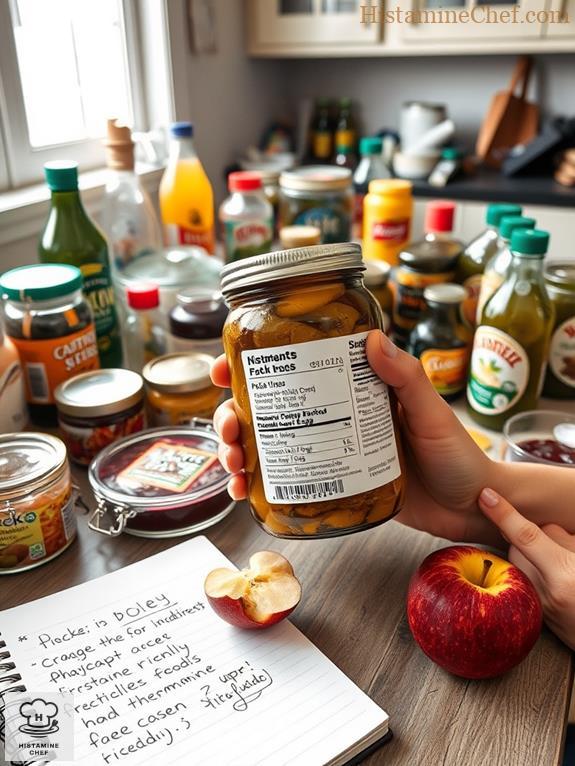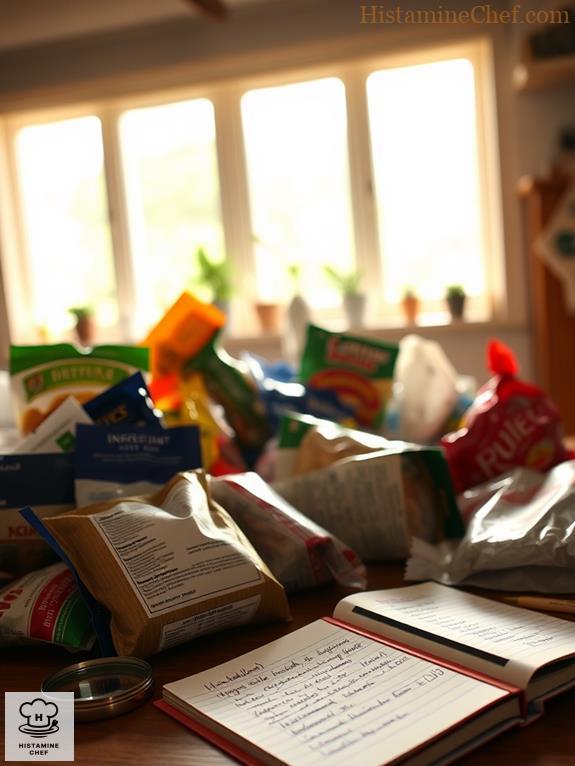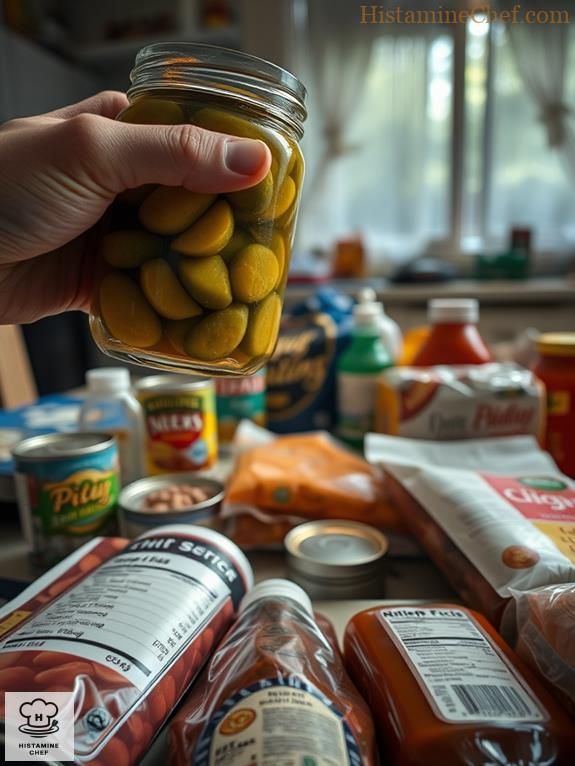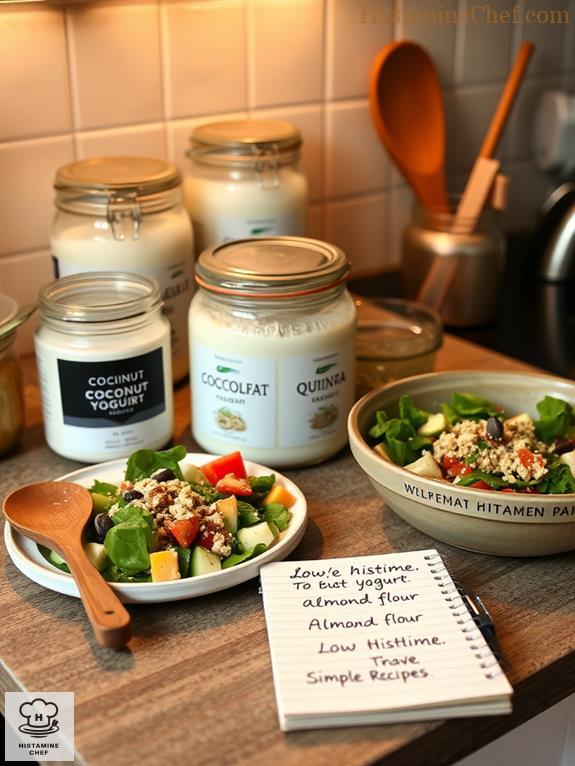Ever felt lost in the supermarket labyrinth? I’ve been there!
I’m on a mission to decode food labels for us histamine-sensitive folks. It’s like playing detective, but way tastier!
I’ve learned to spot sneaky words like “fermented” and “aged”. They’re histamine bombs waiting to happen!
Fresh is best – apples, carrots, you name it. I’ve ditched processed junk for whole foods. Trust me, your body will thank you.
Cooking with fresh herbs? Game-changer! It’s all about those low-histamine flavors.
Got questions? I’m here to help you stay histamine-smart!
My Supermarket Showdown: A Histamine Hunter’s Tale
Last week, I had a real eye-opener at the grocery store. Armed with my SIGHI list and a newfound determination, I scanned every label like a pro.
I nearly high-fived a stranger when I found histamine-free tomato sauce!
But then came the cheese aisle – talk about a minefield. I ended up chatting with the deli guy about fermentation processes.
Who knew shopping could be so educational?
It’s a journey, but I’m getting better at navigating this histamine maze every day.
Understanding Histamine Sensitivities

Understanding histamine sensitivities can be quite challenging, especially when trying to navigate food choices. I get it! One minute you’re enjoying a delicious meal, and the next, you’re dealing with histamine reactions. It’s like a surprise party you never wanted.
Histamine-related disorders, also known as histaminosis, can manifest in various ways, affecting different body systems. Understanding these conditions is essential for effective management.
Histamine intolerance can throw a wrench in your plans, but knowledge is your best weapon!
When you look at the SIGHI list, you’ll see that many foods are labeled as low or high histamine. For instance, apples and quinoa are your friends, while tomatoes and aged cheeses? Not so much.
Key Ingredients to Avoid

Steering through the world of food with histamine sensitivity can feel overwhelming at times, but avoiding key ingredients is essential for maintaining comfort and health.
I’ve learned that some common allergens, like fermented dairy and specific legumes, can really ramp up histamine levels. Yikes! While traditional favorites like sauerkraut and kimchi are off-limits, there are delicious low-histamine alternatives that can satisfy your cravings without triggering symptoms. These substitutes often provide similar flavors and nutritional benefits.
When I shop, I always check ingredient sourcing—fresh is best! Those sneaky processed snacks? They often hide high-histamine ingredients like soy sauce or certain oils.
And keep in mind, that tempting chocolate bar? It’s a no-go! Stick with apple slices instead; they’re sweet and histamine-friendly.
Deciphering Food Labels

When I’m scanning food labels, I always look for hidden ingredients that might sneak into my cart. It’s like a treasure hunt, but instead of gold, I’m after safe foods!
I focus on label terminology, like “fermented” or “aged,” which can indicate high histamine content. If you see terms like “canned” or “smoked,” run the other way!
For those missing tomato sauce, there are delicious alternatives that can satisfy your cravings without triggering histamine reactions.
Ingredient sourcing matters too. Fresh, whole foods are my allies, while processed items often hide trouble.
Navigating the SIGHI list keeps me empowered—apples and blueberries? Yes, please! But avocados? Nope!
Safe Shopping Practices

Grocery shopping can feel like maneuvering through a maze, especially when I’m on the hunt for low-histamine options. To master safe shopping, I focus on mindful choices.
Smart cooking techniques can also help reduce histamine content in meals, so I keep these in mind while selecting ingredients.
First, I bring my trusty SIGHI list with me. It’s my secret weapon! I avoid restricted foods like tomatoes and aged cheeses while stocking up on allowed goodies like blueberries and fresh meats.
And hey, don’t forget to check expiration dates. Nothing says “surprise histamine explosion” like an old can of tuna!
I’ve learned to trust my instincts; if something feels off, I skip it.
Reading Ingredient Lists

When I scan ingredient lists, I feel like a detective on a tasty mission!
It’s essential to spot those allowed ingredients that score 0 or 1 on the SIGHI list, while keeping an eye out for restricted components that could send my histamine levels soaring.
Smart substitutions can help adapt recipes for low histamine cooking, making it easier to enjoy a variety of foods.
Identifying Allowed Ingredients
Understanding which ingredients are allowed can make a significant difference in managing histamine sensitivity.
You’ll feel empowered as you navigate ingredient lists with confidence!
Start with allowed vegetables like carrots and zucchini, and sweeten your day with allowed fruits like apples and blueberries.
Craving comfort? Reach for allowed starches like quinoa or rice.
For protein, think allowed meats like fresh chicken and turkey.
Don’t forget allowed dairy options like young cheeses and butter, and drizzle in allowed oils like extra virgin olive oil.
Spice things up with allowed herbs, and sweeten your meals with honey or maple syrup.
With allowed drinks like peppermint tea, you’ve got this!
Let’s decode those labels together—your histamine-smart journey awaits!
Recognizing Restricted Components
As you confidently navigate ingredient lists, it’s just as important to recognize restricted components that can trigger histamine reactions. You know, those sneaky culprits hiding in your favorite snacks!
For instance, watch out for restricted ingredient examples like aged cheeses and dried meats.
These common food additives, such as vinegar and soy sauce, can turn a delicious meal into a histamine nightmare.
Next time you’re shopping, take a moment to scan for these offenders.
Keep in mind, I write this blog, Histamine Chef, to help you master your histamine-smart journey.
So, why risk a reaction when you can make informed choices?
Empower yourself by knowing what to avoid.
Your body will thank you, and that’s worth celebrating!
Low Histamine Substitutes

Finding low histamine substitutes can be a game-changer for those sensitive to histamines. Visualize snacking on a juicy peach or blueberries without worry!
When cooking, consider histamine-friendly herb swaps to enhance flavor without triggering reactions. Fresh herbs like basil, cilantro, and parsley are excellent low-histamine options.
I’ve discovered that choosing low histamine snacks, like rice cakes topped with fresh mango, truly elevates my snack game.
For histamine-free meals, think quinoa salad with fresh veggies—yum!
Avoid foods high in histamines, like aged cheeses or fermented products. Instead, reach for young cheeses or fresh meats. They’ll keep your body happy and your taste buds satisfied.
Cooking Tips for Histamine Safety

When cooking for histamine safety, I always prioritize fresh ingredients. Fresh foods not only taste better but also pack fewer histamines! So, when I prep my meals, I make sure to shop from the SIGHI list—think vibrant apples, juicy blueberries, and crisp vegetables.
Smart food storage is vital for maintaining low histamine levels in your meals. Proper refrigeration and quick consumption of leftovers can greatly reduce histamine buildup.
Proper ingredient storage is key too! I’ve learned the hard way that keeping foods in the fridge for too long can turn them into histamine factories. So, I freeze what I can and enjoy fresh meals.
And let’s not forget about variety! Mixing it up keeps things exciting. Got leftover quinoa? Toss it with fresh herbs and some grilled chicken for a powerhouse meal.
Keep in mind, you control your plate; don’t let histamines control you!
FAQ
What Are the Symptoms of Histamine Intolerance?
I’ve experienced common triggers of histamine intolerance, like headaches and digestion issues. It’s frustrating when my body reacts negatively to certain foods, but understanding my limits empowers me to make better choices.
Can Histamine Levels Vary in the Same Food?
Absolutely, I’ve noticed histamine levels can vary in the same food. Factors like food storage and fermentation effects play an essential role. Understanding these nuances empowers me to make better choices for my health.
How Can I Test for Histamine Sensitivity at Home?
To test for histamine sensitivity at home, I suggest starting an elimination diet. Remove high-histamine foods, then slowly reintroduce them while monitoring reactions. This empowers me to identify triggers and regain control over my health.
Are There Any Medications That Affect Histamine Levels?
I’ve noticed some medications can really affect histamine levels. Antihistamines help reduce symptoms, but dietary interactions can enhance or diminish their effectiveness. It’s essential to stay informed and manage both for ideal results.
How Long Does It Take to Feel Better on a Low Histamine Diet?
I’ve noticed that my healing timeline can vary, but with consistent diet adjustments, I often feel significant improvements within a few weeks. Staying committed empowers me to better manage my histamine levels effectively.
Summary
I’ve learned to decode food labels, transforming my shopping experience. Understanding histamine sensitivities helps me choose low-histamine options confidently. Through my blog, Histamine Chef, I aim to guide others in navigating these challenges, keeping our plates full and histamine levels low.
What’s your experience with reading food labels for histamine sensitivity? Share your insights or challenges in the comments below.
If you found this information helpful, please share this post on social media. Your support helps Histamine Chef reach more people struggling with histamine intolerance.


Leave a Reply